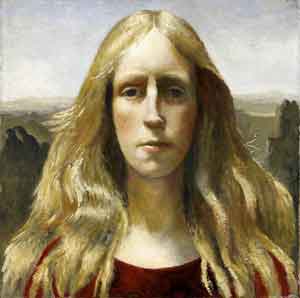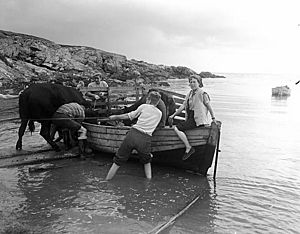Brenda Chamberlain (artist) facts for kids
Quick facts for kids
Brenda Irene Chamberlain
|
|
|---|---|

Self portrait, 1938
(National Museum Wales) |
|
| Born | 17 March 1912 Bangor, Wales
|
| Died | 11 July 1971 (aged 59) Bangor, Wales
|
| Nationality | Welsh |
| Education | Royal Academy Schools |
| Known for | Painting, poetry |
| Spouse(s) | |
Brenda Irene Chamberlain (born March 17, 1912 – died July 11, 1971) was a talented Welsh artist, poet, and writer. She made history by winning the first two Gold Medals for Fine Art at the National Eisteddfod of Wales. These awards were for her paintings Girl with a Siamese Cat (1951) and The Cristin Children (1953).
Brenda also wrote books, including Tide-race. This book shares her experiences living for 15 years on Bardsey Island, a small island off the coast of Wales. She also lived for a time on the Greek island of Hydra from 1961 to 1967. She then returned to Wales, where she passed away in 1971. Her writings and artworks are kept in important collections, like the National Library of Wales.
Contents
Early Life and Learning
Brenda Chamberlain was born in Bangor, Wales. Her father, Francis Thomas Chamberlain, worked for the railway. Her mother, Elsie Cooil Chamberlain, was also very active in their community. She served on the Bangor Borough Council and later became the Mayor of Bangor during World War II.
In 1931, Brenda began her journey to become an artist. She started studying at the Royal Academy Schools in London. This is a famous art school where many artists learn their skills.
Her Creative Works
Brenda Chamberlain was very creative and worked on many projects. She helped run the Caseg Press in Bethesda, Wales. She worked with her husband at the time, artist John Petts, and poet Alun Lewis.
At Caseg Press, they made postcards and special bookplates. Brenda created many of the designs using woodcuts, which is a type of printmaking. They also published Caseg Broadsheets, which featured poems by Brenda and other writers. The cottage where they lived, called Ty'r Mynydd, has a special plaque to remember their work.
Brenda also wrote several books. One of her most famous is Tide-Race (published in 1962). This book is a true story about her life on Bardsey Island. She lived and worked there from 1947 until 1962. When Tide-Race was released, Brenda also had an art show in London to display her paintings.
Brenda won the first two Gold Medals for Fine Art at the National Eisteddfod of Wales. She won in 1951 for her painting Girl with a Siamese Cat. Then, in 1953, she won again for The Cristin Children. These were big achievements for her art.
In 1961, Brenda moved to the Greek island of Hydra. She lived there for several years before returning to Wales in 1967. Her novel A Rope of Vines is inspired by her experiences on Hydra. She also wrote a play called The Protagonists (published in 2013), which was first performed in 1968.
Her Lasting Impact
Brenda Chamberlain's artworks are kept in many important places. You can find her paintings in the National Museum Wales, the National Library of Wales, Bangor University, Cyfarthfa Castle, and Royal Holloway, University of London.
The National Library of Wales also has a special collection of her personal papers. This includes her sketches, letters, poems, photographs, diaries, and other writings that were never published. These help us learn more about her life and work.
Two biographies have been written about Brenda Chamberlain. Kate Holman published one in 1997, and Jill Piercy published another in 2013. These books help keep her story and her art alive for future generations.
Her Life Journey
Before the Second World War, Brenda Chamberlain moved in with artist John Petts. They got married in 1935. In 1936, they moved to Rachub, a small village near Bethesda. The cottage they shared, Ty'r Mynydd, has a plaque to remember their creative work there. They later separated in 1944.
Brenda Chamberlain passed away in 1971. She was buried in Glanadda Cemetery in Bangor, her hometown.
Books She Wrote



